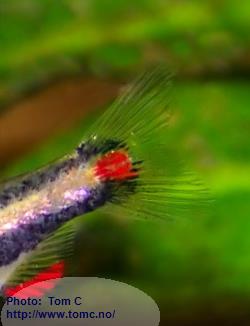Taxonomy
Eigenmann, 1909
Primary, secondary and tertiary bands well developed. This species never shows an adipose fin.
Many of the numerous different populations/color-forms represent most likely indigenous own species.
As an example could be mentioned that the color form found in the Río Negro, Brazil, and a few others, have
thickened fin rays in the anal fin, something other forms do not possess.
A revision of this group is expected to give very interesting results.
Synonyms
Nannostomus marginatus picturatus, Hoedeman, 1954
This name is mostly used for the form with a red blotch between the primary and secondary stripes on the caudal peduncle at the base of the tail fin:

Distribution and habitat
Reported from the following areas:
The rivers of French Guiana and Suriname.
The area of the lower Amazon in Pará, apparently also the upper Rio Branco (Roraima, Staeck [1998]
The middle and upper Rio Negro (Brazil) and the upper Orinoco (Venezuela)
The upper Amazon, the Rio Putumayo in Peru (on the border with Colombia), the Rio Napo in Peru and Ecuador to the Rio Caqueta in Colombia.
The Moa River, a tributary of the Jurua (Acre), in Brazil
The Rio Ampiyacu area and other locations in Peru
The Leticia area in southern Colombia
I have collected them in many of these places, and also in many other locations, as you may read when looking at the photos above.
Water parameters
PH : 4 - 6
ppm : As low as possible
My Experience
One of the best dither fish for my Apistogramma.
They eat everything I offer, they don't eat much eggs or fry from other fish, they don't bother other fish much, they are active and show fabulous colors. A wonderful fish!
Breeding
They spawn in my tanks, among floating plants and in Javamoss.
A few fry continuously grow up, even if there are dwarf cichlids in the same tank.